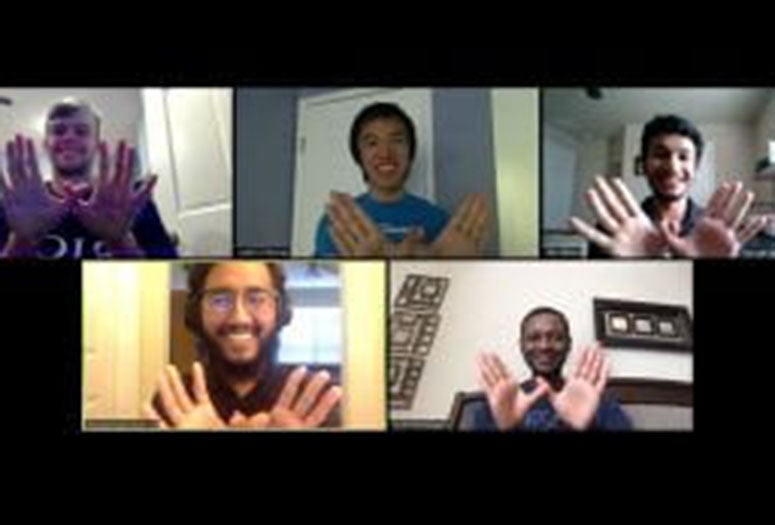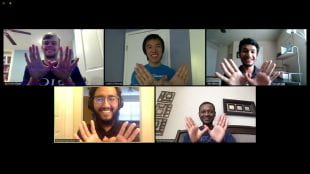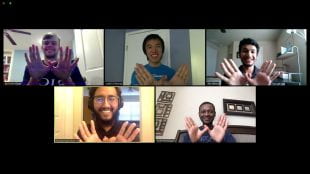Top honors in the 2020 Rice Design-A-Thon went to a team of Rice engineering students who created SchoolTrace, software using the schedules of students and faculty to approximate COVID-19 contact tracing in schools -- without the privacy concerns of tracking sensors or apps on mobile phones.
SchoolTrace creators Justin Cheung, Nick Glaze, Mit Mehta, Tyler Montague and Huzaifah Shamim, who competed as "Team ELECtrifying," are juniors majoring in electrical and computer engineering. In addition to the $1,000 top prize, the team also snagged the $500 prize for top honors in one of the contest's three design tracks, the digital age of health care.
The coronavirus pandemic influenced every aspect of the virtual design-a-thon held July 17-19, a weekend engineering design competition similar to a traditional code-based "hackathon." This year's event was originally planned as an in-person event during the fall semester, but organizers advanced the date and made it a virtual event after the pandemic impacted so many students' summer plans and internships.
"We wanted to provide students with a meaningful summer opportunity and the potential for a significant public health impact," said design-a-thon co-coordinator Carrigan Hudgins, a Sid Richardson College senior. "At one point, we considered cancelling, but hosting it virtually instead actually allowed us to reach a broader base of students across Texas and out of state."
The weekend contest drew 23 teams that included 116 undergraduate competitors.
Second and third place overall won prizes of $800 and $600, respectively, and each of three design tracks were awarded $500 prizes. The awards were sponsored by Rice's George R. Brown School of Engineering, Rice's student chapter of the Biomedical Engineering Society and the Southwest National Pediatric Device Innovation Consortium (SWPDC).
Prize winners walked away from the contest with more than money. Competition co-coordinator Franklin Briones said students will be able to cite their victory when applying for maker grants, inventor grants and entry into other competitions.
"Having the judges and our team vouch for the actual solution, when we can propose it to different competitions and incubators around Texas and the country, is more important than the cash prizes," said Briones, a Brown College senior who competed in previous design-a-thons at Rice. Briones and Hudgins co-coordinated this year's event with Wiess College senior Eric Torres.
When the pandemic forced universities worldwide to cancel summer programs, Briones, Hudgins, Torres and other organizers shifted to planning a virtual, summer competition and met online twice a week through the summer.
"Team SARS Wars: A New Hope" earned second place overall and took home the pediatric track's SWPDC Pediatric Prize for designing a new soap dispenser attachment, which plays music and rewards children with stickers if they wash their hands for the 20 seconds recommended by the Centers for Disease Control and Prevention. The cost-effective device features a timer, infrared sensors and a speaker that plays a song with hand-washing instructions. Team members were Anyssa Castorina, Aman Eujayl, Diego Lopez-Bernal, Janet Lu, Rubén Sebastián Marroquín and Belén Szentes, all sophomores from Rice.
Third place overall went to "The (d^3x/dt^3)(s)," a team of juniors and seniors from the University of Texas at San Antonio that created COV-COM, a wall-mounted filtration device for commercial settings that catches and inactivates the COVID-19 virus. Their invention includes several sensors and an app that business owners can use to remotely activate the device; the general public can use the app to monitor store sanitization and make decisions based on their risk tolerance. Team members were Olivia Garza, Juan Herrera, Frida Montoya, Aishwarya Sathish, Samantha Strahan and Morgan Struthers.
Another Rice team, "The Duncaroo Designers," captured top honors in the global health track for designing affordable desk partitions that could be used in schools with limited funds. Team members were senior Rachel Bui and sophomores Jacob Duplantis, Charlie Gorton, Andrei Mitrofan, Anh Nguyen and Vivian Wong.
All of this engineering creativity happened on a tight schedule. The teams preregistered but the students didn’t know what they would be asked to design until the opening ceremony Friday evening. Teams made initial presentations Saturday evening and final presentations Sunday afternoon, doing all of their work in less than 48 hours.
Organizers asked teams to "design and present a solution (either a product or a method) to address the treatment, prevention or non-medical related needs of the COVID-19 pandemic."
Briones said one of the biggest challenges for organizers was coming up with a design prompt and design tracks amid the ever-changing backdrop of the COVID-19 pandemic.
"The needs-finding for those problems was the most cumbersome part," Briones said. "Not because it's hard to find problems, but because COVID-19 is so continually changing. It was hard to find which problem was the most important one."
Judges included professionals involved in public health, medicine, academia and medical innovation. Winners were chosen based on impact, concept development, innovation, implementation and presentation.



